By the 1938-39 season, a pattern had developed at Termite Terrace. That season, Warner issued 14 black-and-white Looney Tunes cartoons, and no fewer that 26 Technicolor Merrie Melodies. That trend toward higher color output would continue through the remaining years of black and white distribution, until the point where Looney Tunes and Merrie Melodies became indistinguishable due to all color production. Many of these cartoons may be familiar to long-time cartoon watchers from frequent runs on television, as part of AAP’s package of shorts syndicated beginning in 1956.

Cracked Ice (9/10/38) – Follies and gags upon the ice and snow, complete with a return of portly pig W.C. Squeals in a scheme to obtain a St. Bernard’s brandy barrel, that backfires him into a skating race. This cartoon has been brought up in the Animation Trails article, “Magnetic Personalities” on this website for its extensive use of underwater magnet gags. Songs include old standard favorites such as “Jingle Bells”, “Blue Danube”, “Oh Where, Oh Where Has My Little Dog Gone”, and “Lezginka” (for a pair of Russian wolfhounds – a go-to piece for Stalling for anything suggesting old Russia). The more current “Sissy” also appears again. A race-speed version of “Little Brown Jug” accompanies the climactic chase. Here’s Glenn Miller’s 1939 recording:
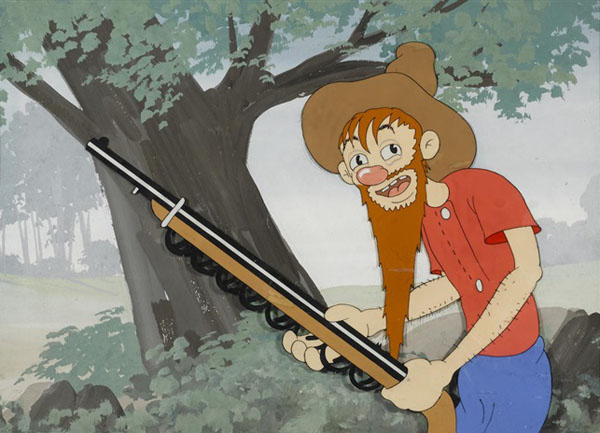
A Feud There Was (9/24/38) – Tex Avery’s gag-filled exploration of mountain mayhem, with gags not only deriving from the feud between the McCoys and the Weavers, but even a reference to Wrong-Way Corrigan (a then famous pilot who flew to Ireland, allegedly by mistake with intention to fly to California). Egghead mow assumes the new name onscreen of “Elmer Fudd, Peace Maker”. (The Elmer name was revealed by Jerry Beck’s series of lobby cards as having been tagged to the character as early as “The Isle Of Pingo Pongo” – still, as he continues to act like the character of old, I will continue to refer to him as Egghead.) One line of dialogue almost encapsulates Tex Avery’s credo : “In one of these here now cartoon pictures, a body can get away with anything.” Old favorites include “Arkansas Traveler” (below, Jimmy Dorsey’s 1938 recording), “The Old Gray Mare”, and “Chicken Reel”. along with an original number about “We’re in the Mood to Kindle Up a Feud”, sung by a group that sounds an awful lot like the Sons of the Pioneers (and interrupted by a commercial offering loans on old shotguns).
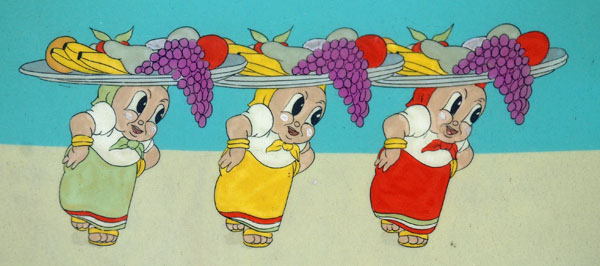
Little Pancho Vanilla (10/8/38) – Little Pancho wants to be a bullfighter. Mamacita just wants him to be a little boy, while she toils away with her washboard. Pancho is not to be dissuaded by either Mama or the manager of the bull ring. He winds up in the ring with the bull, and wins for Mamacita a new washing machine. Songs include “La Cucaracha”, “In Caliente” (theme from the movie of the same name – I know of no commercial recordings of same), and “Muchacha”, also from the same picture, and recorded by Phil Regan in 1935 for royal blue Columbia.

Johnny Smith and Poker-Huntas (10/22/38) – A takeoff on tales of the pilgrims, and John Smith and Pocahontas, starring Egghead as the unlikely hero. Historical evidence seems to indicate the native Americans had intent to brain John Smith with a war club rather than chop his head off – but Tex Avery opts for the greater visual dramatics of the traditional yarn. Songs include “Columbia, the Gem of the Ocean”. “Dixie” (how did that get in there?), “My Old Kentucky Home”, and “Aloha Oe (Farewell To Thee)”.
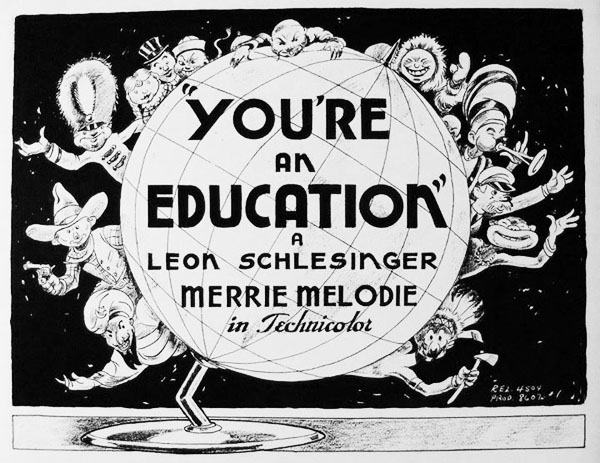
You’re an Education (11/5/38) – Midnight in a travel agency, with the images of all the travel folders breaking into song. Much animation reused from previous films, including brief shots from “Flowers for Madame”, “Little Dutch Plate”, and possibly from “Have You Got Any Castles?” Eventually it develops into a crime/chase plot, with the Thircf of Baghdad using the Florida keys to open up the Kimberley Diamond Mines, then trying to sell his stolen swag to the Pawnee Indians. The other countries gang up on him as usual, dipping him in several color seas (Red, Black, and Yellow), and surprisingly winding him up riding behind the saddle of the Lone Stranger.
Songs: a long medley of pieces which would have been familiar or memorable to a 1939 theatre audience, including “Let the Rest of the World Go By”, “Have You Got Any Castles, Baby”, “Wearin’ of the Green”, “Bei Mir Bist Du Schon”, “We’re Working Our Way Through College” (from “Varsity Show”), “Aloha Oe”. “Blue Danube Waltz”, “Avalon”, “Congo”, “Song of the Volga Boatmen” “Lezginka”. “Puppchen”. “Night Over Shanghai” (a Dick Powell song from “The Singing Marine” recorded for Decca), and “I Love a Parade”, among others. The title song (presented in the cartoon with special lyrics), was recorded by Bob Crosby for Decca and for World Transcriptions, and for Victor by Larry Clinton and his Orchestra with vocal by Bea Wain. “When Yuba Played the Rumba on the Tuba”, a 1931 number written by Herbert Hupfeld for the third “Little Show” review, gets a feature production number here. In its day, it was recorded by Rudy Vallee on Victor, Ben Selvin’s studio band on Harmony, Velvet Tone, and Clarion, Al Lack’s City Radiolians on Crown, and The Six Jumping Jacks (a Harry Reser group) on Brunswick, and as a vocal by The Revelers (also on Victor), and in England by Ambrose on HMV, and by a Jay Wilbur group called the Hottentots on Eclipse (an 8″ record sold at British Woolworth stores for sixpence).

The Night Watchman (11/19/38), Chuck Jones’ directorial debut. The cat whose normal job is to guard the kitchen against mice is indisposed (possibly for a liquid reason), and his young son has to take over for the night. The mice gang up on him, but he eventuually musters up his own courage and defeats the mice. The young cat is a sort of proto-Sniffles, predicting some of the character traits and voice that would become later associated with Jones’ mild-mannered rodent. Songs include “I Can’t Face the Music (Without Singing the Blues)”, recorded by Larry Clinton for Victor, Teddy Wilson for Brunswick (for once without Billie Holiday), and by Mildred Bailey on Vocalion; “The Latin Quarter”; “In the Shade of the Old Apple Tree”; and “Bei Mir Bist Du Schon”.
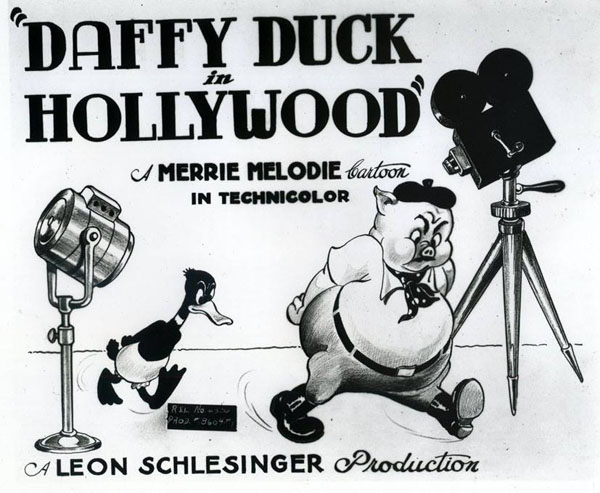
Daffy Duck in Hollywood (12/3/38) – Daffy is at the “Warmer Brothers” studio, being his usual self and causing mayhem for director Mark Hamburger. With an imappropriately large amount of film cement, Daffy creates a feature out of dribs and drabs from the newsreel vault and other archival sources, and unseats the director from his chair (but not from a role reversal where Hamburger becomes the wacky troublemaker). Songs: “You Ought To Be in Pictures”, “Garden of the Moon”, “Congo”, and “California, Here I Come”.
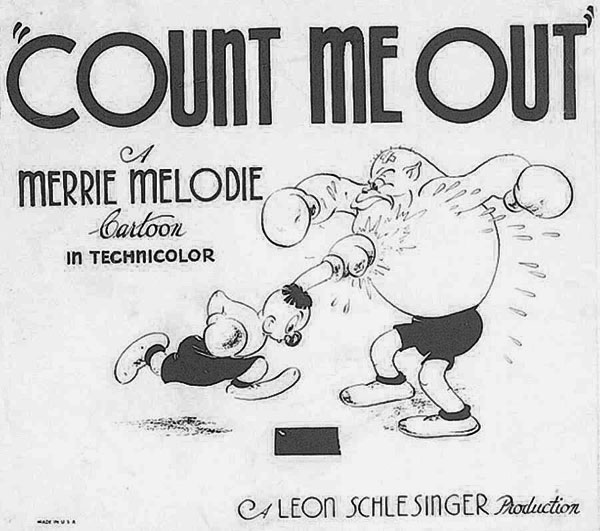
Count Me Out (12/7/38) – Believed to be the first Warner cartoon to make reference to the “Acme” company (this time offering a record correspondence school course on boxing, complete with punching bags, automatic punching gloves to spar with, and other equipment). Egghead passes the graduate course, and decides to take his knowledge on the road. Unfortunately, a prize bout with “Biff Stew” turns out to be more than he can handle. It all turns out to be a dream induced by a knockout punch, and Egghead throws the whole kit and caboodle of his course equipment out the window. Songs: “Let That Be a Lesson To You”, “Home Sweet Home”, “Please Be Kind” (recorded by Benny Goodman for Victor, The Original Dixieland Jazz Band for Bluebird, and Red Norvo/Mildred Bailey for Brunswick – the song became something of a standard), and “You Go To My Head”.
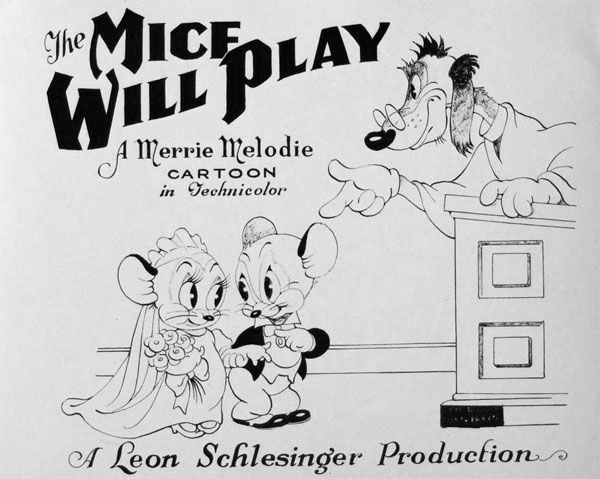
The Mice Will Play (12/31/38) – A weak Tex Avery title, but with a clever payoff. The mice are playing in a science lab, not realizing that in the next room, a female of their species is crying for help, set to be experimented upon. She is rescued, and she and her rescuer marry (“Don’t spare the rice”). All the while a cat has been stalking the mice with culinary ambitions. The bride notes to her groom that now that they’re married, by and by there’ll be lots and lots of little fat mice. “Little fat mice?”, ponders the cat. “Hmmm….I think I’ll wait!” Songs include “Chicken Reel” (accompanying a microscope slide of Chicken pox), “Garden of the Moon”, and Mendelssohn’s Wedding March with special lyrics, delivered in a vocal style similar to the Top Hatters or Jimmie Lunceford’s vocal trio.
Dog-Gone Modern (1/14/39) – Two stray puppies enter a “House of Tomrrow”, to find themselves kerflummoxed by all the modern gizmos and gadgets – especially an “automatic sweeper” robot that won’t give up. Songs: a great deal of “At Your Service, Madame”, which had almost been forgotten in the three years since it first got used. Also included were “Home Sweet Home” and “The Little Old Fashioned Music Box”, accompanying a highly contraptive player piano/orchestra. Here’s a cute version via Johnny Johnson and his Orchestra (of Perfect Records):
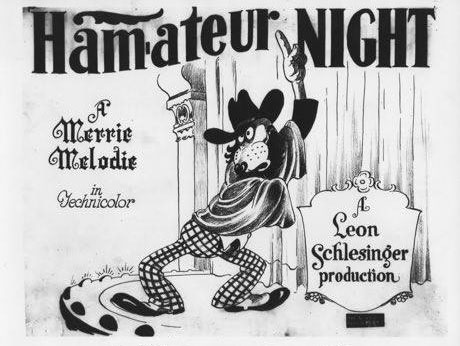
Hamateur Night (1/28/39) – Amateur night at the local theater, where most acts get dropped down trap doors of varying sizes to their doom. Egghead wins the event without even formally entering, as the audience vote is compiled from a theater of his look-alike twins (predicting later Avery gags on look-alikes for both Bugs Bunny and Droopy). Sings include “The Merry Go Round Broke Down”, “Confidentially” (a song from “Garden of the Moon”, but with no known commercial recordings), “The Girl Friend of the Whirling Dervish” (also from “Garden of the Moon”, cut by Skinnay Ennis for Victor, George Hall (billed as Dolly Dawn and her Dawn Patrol) for Vocalion, as well as a country version for Vocalion by the Hoosier Hot Shots, Van Alexander for Bluebird, and Guy Lombardo for Decca), and the old rustic number, “She’ll Be Comin’ ‘Round the Mountain”, is featured as Egghead’s recurrent musical interruption.
 Robin Hood Makes Good (2/11/39) – No doubt inspired by the Errol Flynn box office hit, three squirrels attempt to play Robin Hood in the woods, with the smallest squirrel drafted unto playing the villain. A fox tries to intervene in their play for a tasty meal, but the little squirrel fools him into cowardice, making him literally turn yellow. Then, confronting his friends, he asks, “WHO’S gonna play Robin Hood??” No particular songs recognizable in the score – with the exception of special lyrics (during a musical mock sword fight) applied the tune “For You”, from the 1937 Warner Bros. feature The King and The Chorus Girl – covered by Paul Whitman here on Victor:
Robin Hood Makes Good (2/11/39) – No doubt inspired by the Errol Flynn box office hit, three squirrels attempt to play Robin Hood in the woods, with the smallest squirrel drafted unto playing the villain. A fox tries to intervene in their play for a tasty meal, but the little squirrel fools him into cowardice, making him literally turn yellow. Then, confronting his friends, he asks, “WHO’S gonna play Robin Hood??” No particular songs recognizable in the score – with the exception of special lyrics (during a musical mock sword fight) applied the tune “For You”, from the 1937 Warner Bros. feature The King and The Chorus Girl – covered by Paul Whitman here on Victor:
Gold Rush Daze (2/25/39) – Something of a Technicolor remake of Golddiggers of ‘49, without repeat of prior gags. The closest parallels to its predecessor are reaction gags to “There’s gold in the gulch”. A gas station proprietor tries to talk a young prospector out of the foolhardiness of seeking the fabled metal – but proves just as susceptible as anyone else to gold fever when the call comes of another strike, running for the hills and leaving the gas station to the young prospector. Songs include, “Ride, Tenderfoot Ride”, from Cowboy From Brooklyn, recorded by its star Dick Powell for Decca, Freddy Martin for Victor, Dick Jurgens on radio Transcription, and later to become the title song for a Gene Autry western; “Oh, Susanna”; and “Camptown Races”. Also heard, sung by the miners at the mineshaft, is “The Old Apple Tree”, the M.K. Jerome, Jack Scholl penned for Warner’s feature Swing Your Lady (1938).
Next Time: A rundown of the remainder of the 1938-39 season.


 James Parten has overcome a congenital visual disability to be acknowledged as an expert on the early history of recorded sound. He has a Broadcasting Certificate (Radio Option) from Los Angeles Valley College, class of 1999. He has also been a fan of animated cartoons since childhood.
James Parten has overcome a congenital visual disability to be acknowledged as an expert on the early history of recorded sound. He has a Broadcasting Certificate (Radio Option) from Los Angeles Valley College, class of 1999. He has also been a fan of animated cartoons since childhood.











































Count Me Out also features “There’s a Brand New Picture in My Picture Frame”, which turns up a year later in The Film Fan.
James, this series remains really impressive. Thanks so much for the excellent scholarship — and great audio and video clips. Kudos also to Jerry for those swell title lobby cards!
Not sure if this counts, but an Acme product was first spotted in the background in Buddy’s Bug Hunt (1935)
“So Help Me” by Jimmy Van Heusen plays over the title card for “Hamateur Night”.
I can’t wait for you to review Hare-um Scare-um next time. It’s probably my favorite Merrie Melody of the 1938-39 season. Keep up the great work with these posts.
“When Yuba Plays the Rumba on the Tuba” is a wonderfully surreal Fleischer Screen Song from 1933 featuring the Mills Brothers. Unfortunately their live-action performance of the title song has been cut from the NTA print I found online, but they do a great riff on Irving Berlin’s “Alexander’s Ragtime Band”.
And then in “Long-Haired Hare”, opera singer Giovanni Jones gives Bugs Bunny the punching-bag treatment for playing “When Yuba Plays the Rumba on the Tuba” on his sousaphone. Of course, we know this means war….
“When Yuba Plays the Rumba on the Tuba” is also heard in the MGM Happy Harmonies cartoon “Bottles.”
Found the lobby card for A FEUD THERE WAS
https://www.alamy.com/stock-photo-a-feud-there-was-1938-127732120.html